Get free scan and check if your device is infected.
Remove it nowTo use full-featured product, you have to purchase a license for Combo Cleaner. Seven days free trial available. Combo Cleaner is owned and operated by RCS LT, the parent company of PCRisk.com.
What is naneso[.]com?
Naneso[.]com is a dubious site, akin to vakogid.com, ciessimple.pro, allowpush.club and thousands of others. It is designed to cause undesired redirects to other compromised and potentially malicious websites, as well as present visitors with highly suspect content.
Intentional visits to said site are rare; most users access it by way of redirection from other untrustworthy websites (precisely, through intrusive advertisements there) or by having it opened by rogue applications (PUAs - potentially unwanted applications).
Users should know that their explicit permission is not necessary for these apps to breach their systems. PUAs create redirects, deliver invasive ad campaigns and can even track user data.
![naneso[.]com pop-up redirects](/images/stories/screenshots201906/nanesocom-homepage.jpg)
Proliferation of naneso[.]com is promoted by intrusive adverts and PUAs force-opening new browser tabs/widows and redirected users to it. It should be noted that this rogue website employs browser notifications, which if consented to - present various invasive advertisements.
The naneso[.]com site begins its actions by learning visitor IP (Internet Protocol) addresses, and through them - their geolocation. The latter is vital for the next course of action; either the website redirects users elsewhere or begins feeding them dubious content.
What exact actions it takes is irrelevant, as the most important fact is that visitors to naneso[.]com are bound to encounter malicious matter. For example, intrusive ads can redirect to websites deemed highly hazardous, even execute scripts designed to autonomously download/install PUAs.
Potentially unwanted applications themselves can cause redirects to likewise dangerous sites, as well as deliver aggressively invasive advertisement campaigns. By employing various tools, undesired applications can enable third party graphical content, consequently delivering such obstructive adverts, which can hinder browsing speed and site visibility.
Another infamous ability that PUAs possess is data-tracking. They monitor and gather information on users' browsing activities (URLs visited, paged viewed, search queries and etc.), which inevitably contains traces of their personal details (IP address and info concerning their very identity).
This sensitive data is then passed onto third parties (possibly even cyber criminals), attempting to misuse it for possible profit. In other words, presence of data gathering applications in one's system can lead to serious privacy issues and even identity theft. Therefore, it is crucial to remove all PUAs in order to ensure the safety of one's device and person.
| Name | naneso.com pop-up |
| Threat Type | Push notifications ads, Unwanted ads, Pop-up ads |
| Serving IP Address | 104.27.138.248 |
| Observed Domains | a.naneso[.]com; m.naneso[.]com; s.naneso[.]com; x.naneso[.]com |
| Symptoms | Seeing advertisements not originating from the sites you are browsing. Intrusive pop-up ads. Decreased Internet browsing speed. |
| Distribution Methods | Deceptive pop-up ads, potentially unwanted applications (adware) |
| Damage | Decreased computer performance, browser tracking - privacy issues, possible additional malware infections. |
| Malware Removal (Windows) |
To eliminate possible malware infections, scan your computer with legitimate antivirus software. Our security researchers recommend using Combo Cleaner. Download Combo CleanerTo use full-featured product, you have to purchase a license for Combo Cleaner. 7 days free trial available. Combo Cleaner is owned and operated by RCS LT, the parent company of PCRisk.com. |
The Internet is rife with PUAs, sharing many similarities in-between. Nearly all of them make attempt at appearing legitimate and offering "useful" features.
Although these offers can be tempting, it must be stressed that they are all false and nonfunctional. Unwanted applications serve only one purpose - to generate revenue for their developers; they are of no real value to users. PUAs cause undesirable redirects, bring invasive ad campaigns and gather vulnerable user information.
How did adware install on my computer?
Potentially unwanted applications are spread by aforementioned intrusive advertisements and download/install bundles. "Bundling" is a deceptive marketing method employed by PUA developers to proliferate their product; this term describes install packs, where regular software is prepackaged with undesired applications.
The average user tends to download/install programs quickly and without much care - this is greatly exploited by said developers.
It is often possible to opt-out/decline from installing/downloading these apps, however such options are often hidden within "Custom/Advanced" settings. In summary, reckless browsing habits and rushed downloads/installation processes can result in unwanted and malicious applications infiltrating one's device.
How to avoid installation of potentially unwanted applications?
Caution is key to computer and user safety. Only official and verified sources are recommended for software downloading, preferably via direct download links. Third party downloaders are suspect and much more likely to "bundle" their programs.
Attentively reading and exploring terms and possible options (e.g. not skipping steps), using "Advanced/Custom" settings, opting-out from additional app installation, declining supplementary offers of downloading from elsewhere - is considered part of proper installation protocol, hence strongly advised.
Avoiding dubious sites and refraining from heedless ad-clicking - also helps ensure device and data protection. The latter is doubly important, as intrusive advertisements often appear utterly ordinary - and are easier to fall prey to. However, the websites they redirect to are often more obvious in their questionability, e.g. pornography, adult-dating, gambling and similar.
Should users encounter such ads/redirects prompt actions must be taken - system inspection, followed by removal of all suspicious applications and browser extensions/plug-ins. If your computer is already infected with rogue applications, we recommend running a scan with Combo Cleaner Antivirus for Windows to automatically eliminate them.
Appearance of naneso[.]com website (GIF):
![naneso[.]com website appearance (GIF)](/images/stories/screenshots201906/nanesocom-appearance.gif)
Instant automatic malware removal:
Manual threat removal might be a lengthy and complicated process that requires advanced IT skills. Combo Cleaner is a professional automatic malware removal tool that is recommended to get rid of malware. Download it by clicking the button below:
DOWNLOAD Combo CleanerBy downloading any software listed on this website you agree to our Privacy Policy and Terms of Use. To use full-featured product, you have to purchase a license for Combo Cleaner. 7 days free trial available. Combo Cleaner is owned and operated by RCS LT, the parent company of PCRisk.com.
Quick menu:
- What is naneso.com pop-up?
- STEP 1. Remove spam notifications from Google Chrome
- STEP 2. Remove spam notifications from Google Chrome (Android)
- STEP 3. Remove spam notifications from Mozilla Firefox
- STEP 4. Remove spam notifications from Microsoft Edge
- STEP 5. Remove spam notifications from Safari (macOS)
Disable unwanted browser notifications:
Video showing how to disable web browser notifications:
 Remove spam notifications from Google Chrome:
Remove spam notifications from Google Chrome:
Click the Menu button (three dots) on the right upper corner of the screen and select "Settings". In the opened window select "Privacy and security", then click on "Site Settings" and choose "Notifications".
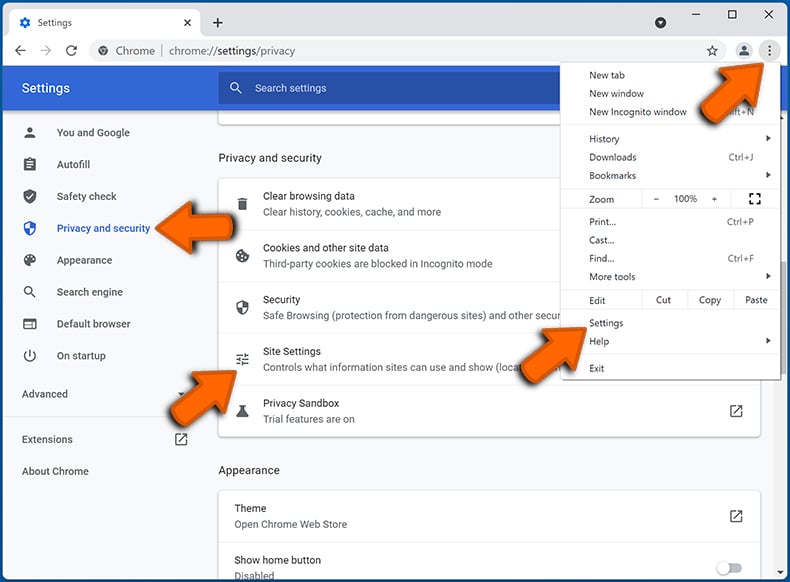
In the "Allowed to send notifications" list search for websites that you want to stop receiving notifications from. Click on the three dots icon near the website URL and click "Block" or "Remove" (if you click "Remove" and visit the malicious site once more, it will ask to enable notifications again).
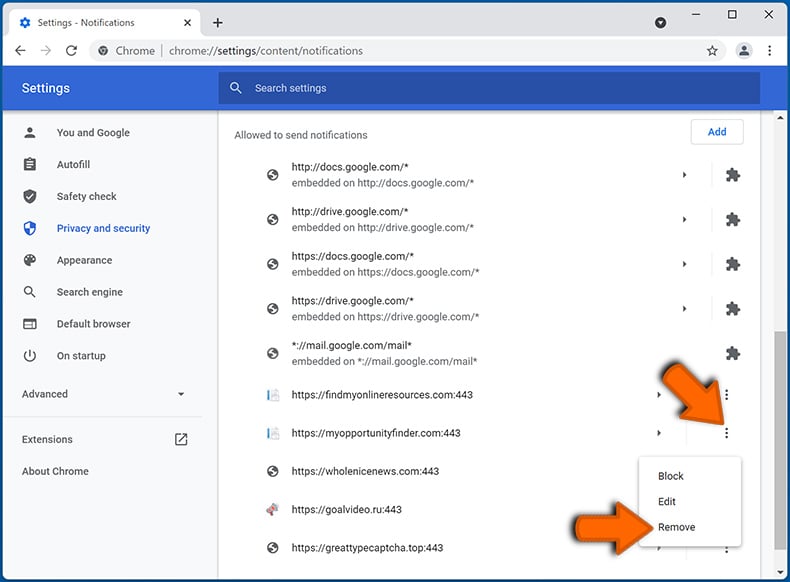
 Remove spam notifications from Google Chrome (Android):
Remove spam notifications from Google Chrome (Android):
Tap the Menu button (three dots) on the right upper corner of the screen and select "Settings". Scroll down, tap on "Site settings" and then "Notifications".
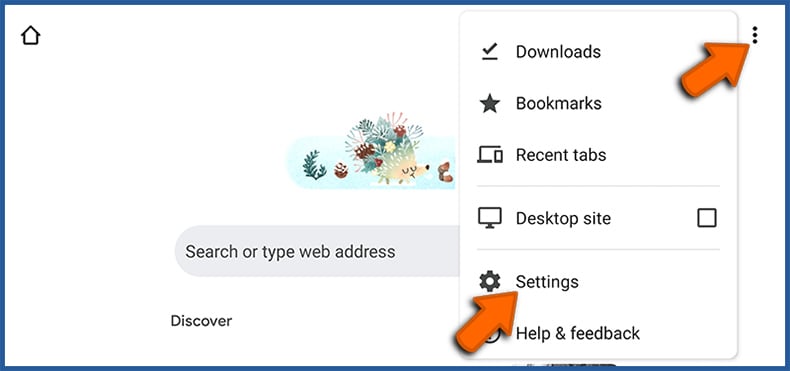
In the opened window, locate all suspicious URLs and tap on them one-by-one. Once the pop-up shows up, select either "Block" or "Remove" (if you tap "Remove" and visit the malicious site once more, it will ask to enable notifications again).
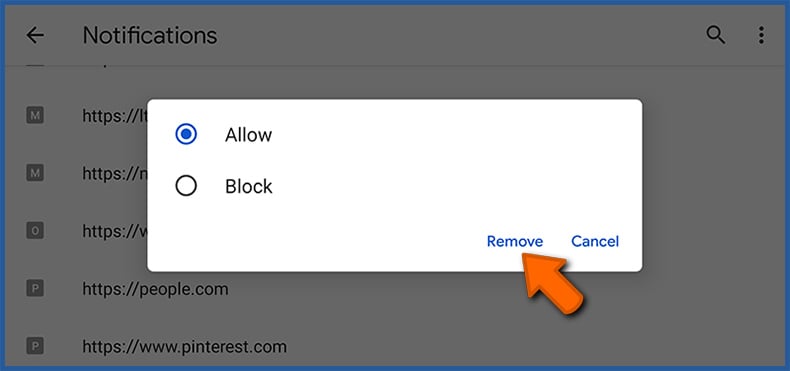
 Remove spam notifications from Mozilla Firefox:
Remove spam notifications from Mozilla Firefox:
Click the Menu button (three bars) on the right upper corner of the screen. Select "Settings" and click on "Privacy & Security" in the toolbar on the left hand side of the screen. Scroll down to the "Permissions" section and click the "Settings" button next to "Notifications".
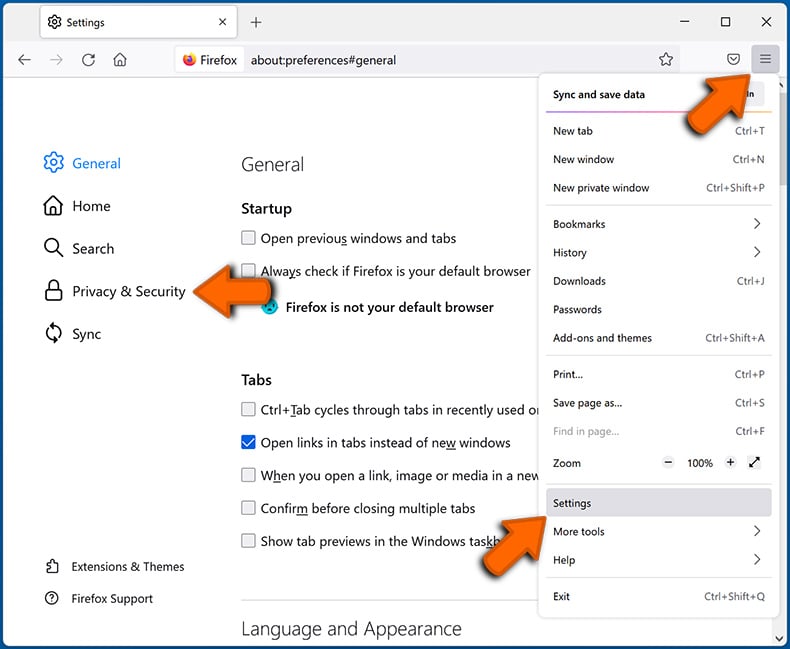
In the opened window, locate all suspicious URLs and block them using the drop-down menu or either remove them by clicking "Remove Website" at the bottom of the window (if you click "Remove Website" and visit the malicious site once more, it will ask to enable notifications again).
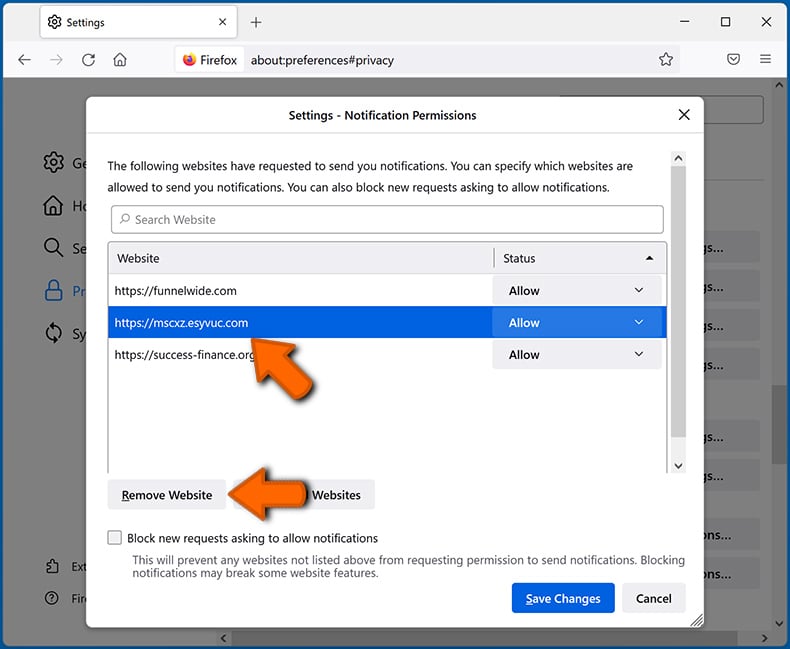
 Remove spam notifications from Microsoft Edge:
Remove spam notifications from Microsoft Edge:
Click the menu button (three dots) on the right upper corner of the Edge window and select "Settings". Click on "Cookies and site permissions" in the toolbar on the left hand side of the screen and select "Notifications".
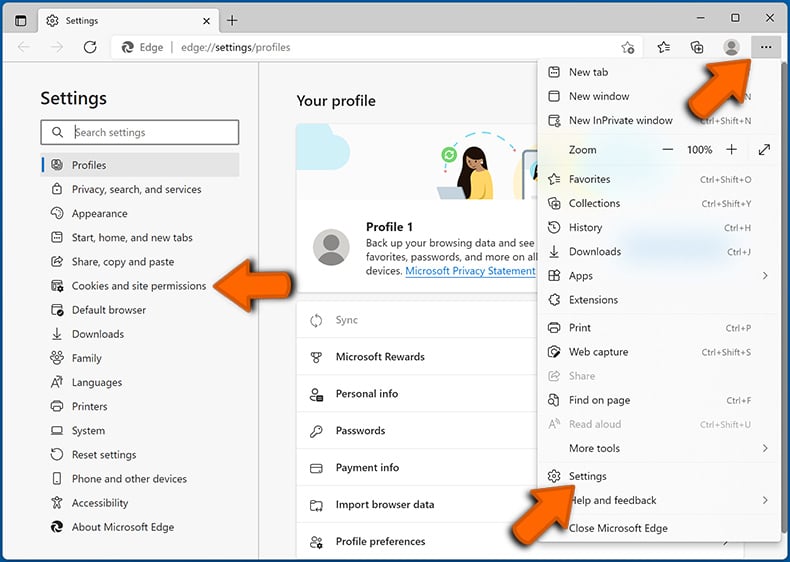
Click three dots on the right hand side of each suspicious URL under "Allow" section and click "Block" or "Remove" (if you click "Remove" and visit the malicious site once more, it will ask to enable notifications again).
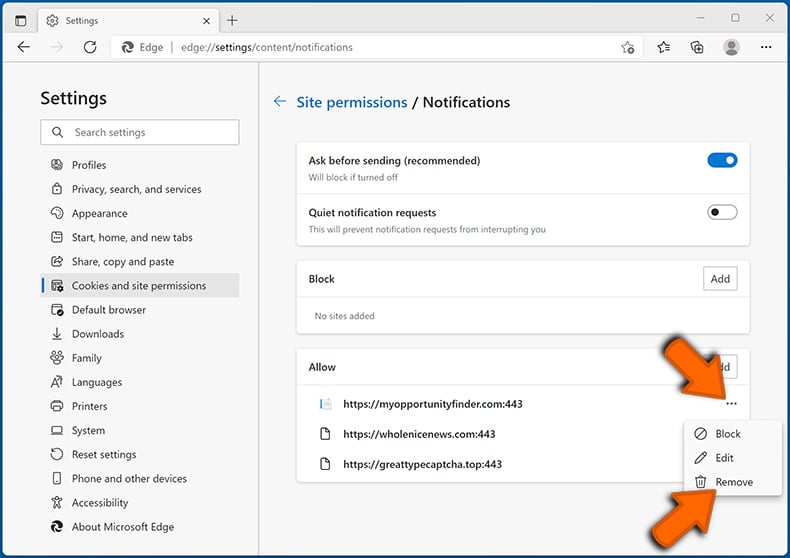
 Remove spam notifications from Safari (macOS):
Remove spam notifications from Safari (macOS):
Click "Safari" button on the left upper corner of the screen and select "Preferences...". Select the "Websites" tab and then select "Notifications" section on the left pane.
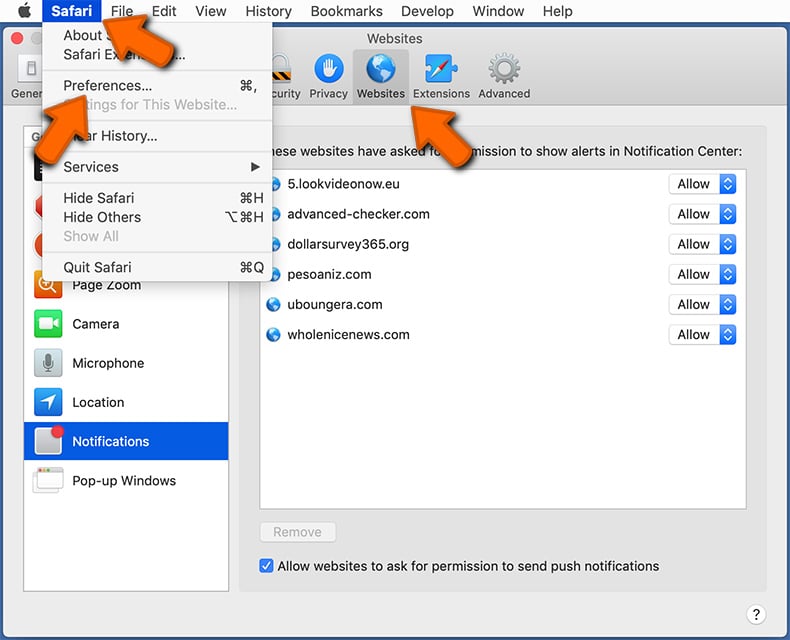
Check for suspicious URLs and apply the "Deny" option using the drop-down menu or either remove them by clicking "Remove" at the bottom of the window (if you click "Remove" and visit the malicious site once more, it will ask to enable notifications again)
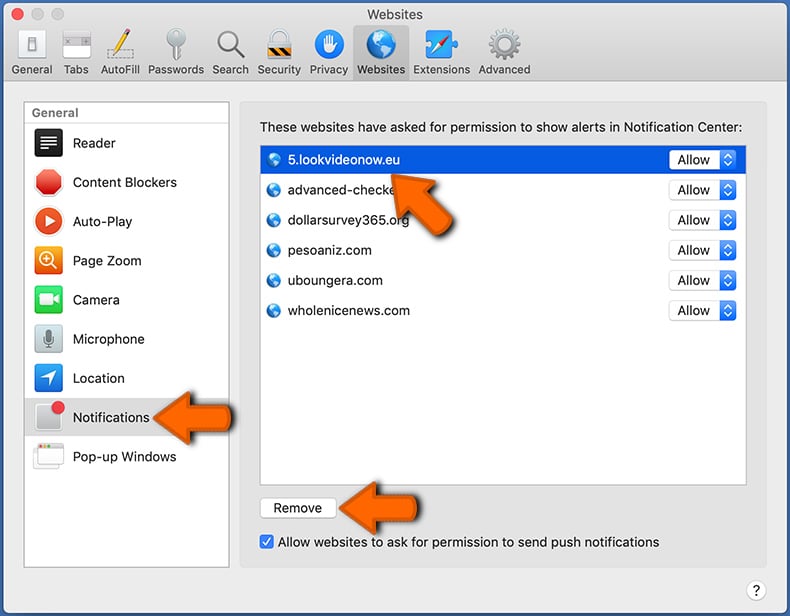
How to avoid browser notification spam?
Internet users should be very skeptical when being asked to allow notifications. While this is a useful feature that allows you to receive timely news from websites you like, deceptive marketers frequently abuse it.
Only allow notifications from websites that you fully trust. For added security - use an anti-malware application with a real-time web browsing monitor to block shady websites that tries to trick you into allowing spam notifications. We recommend using Combo Cleaner Antivirus for Windows.
Share:

Tomas Meskauskas
Expert security researcher, professional malware analyst
I am passionate about computer security and technology. I have an experience of over 10 years working in various companies related to computer technical issue solving and Internet security. I have been working as an author and editor for pcrisk.com since 2010. Follow me on Twitter and LinkedIn to stay informed about the latest online security threats.
PCrisk security portal is brought by a company RCS LT.
Joined forces of security researchers help educate computer users about the latest online security threats. More information about the company RCS LT.
Our malware removal guides are free. However, if you want to support us you can send us a donation.
DonatePCrisk security portal is brought by a company RCS LT.
Joined forces of security researchers help educate computer users about the latest online security threats. More information about the company RCS LT.
Our malware removal guides are free. However, if you want to support us you can send us a donation.
Donate
▼ Show Discussion